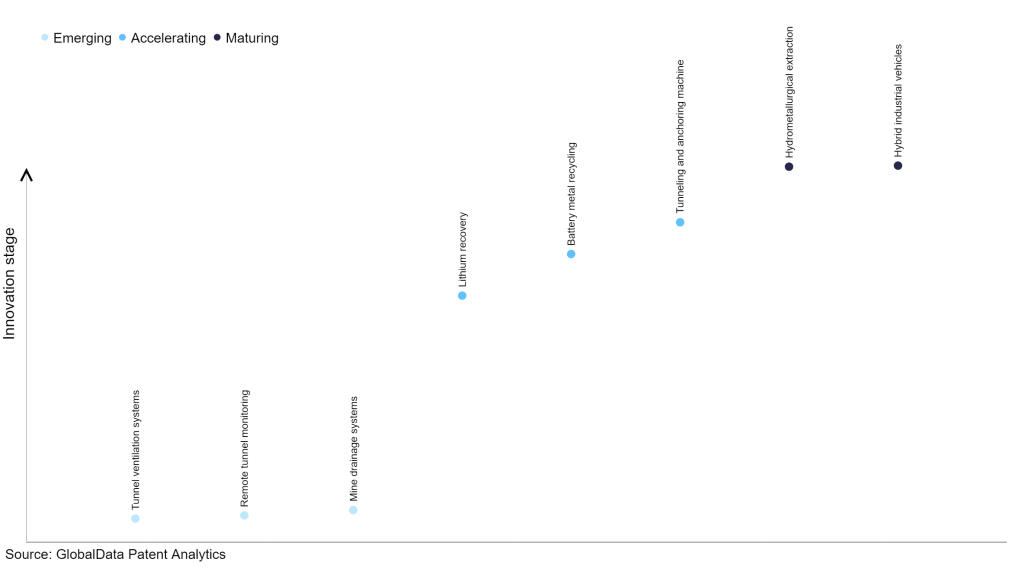The mining industry continues to be a hotbed of patent innovation. Hybrid industrial vehicle drives reduce fuel consumption, reduce the amount of CO2 released into the atmosphere, and assist operations in cost control. In the last three years alone, there have been over 3,000 patents filed and granted in the mining industry, according to GlobalData’s report on Innovation in mining: hybrid industrial vehicles. Buy the report here.
However, not all innovations are equal and nor do they follow a constant upward trend. Instead, their evolution takes the form of an S-shaped curve that reflects their typical lifecycle from early emergence to accelerating adoption, before finally stabilizing and reaching maturity.
Identifying where a particular innovation is on this journey, especially those that are in the emerging and accelerating stages, is essential for understanding their current level of adoption and the likely future trajectory and impact they will have.
45+ innovations will shape the mining industry
According to GlobalData’s Technology Foresights, which plots the S-curve for the mining industry using innovation intensity models built on over 81,000 patents, there are 45+ innovation areas that will shape the future of the industry.
Within the emerging innovation stage, tunnel ventilation systems, remote tunnel monitoring, and mine drainage systems are disruptive technologies that are in the early stages of application and should be tracked closely. Lithium recovery, battery metal recycling and tunneling, and anchoring machine are some of the accelerating innovation areas, where adoption has been steadily increasing. Among maturing innovation areas are hydrometallurgical extraction and hybrid industrial vehicles, which are now well established in the industry.
Innovation S-curve for the mining industry

Hybrid industrial vehicles is a key innovation area in mining
Hybrid industrial vehicles are specialized vehicles that combine traditional internal combustion engines (usually diesel) with electric power systems. These vehicles are designed to improve fuel efficiency, reduce emissions, and enhance the overall sustainability of mining operations.
GlobalData’s analysis also uncovers the companies at the forefront of each innovation area and assesses the potential reach and impact of their patenting activity across different applications and geographies. According to GlobalData, there are 5 companies, spanning technology vendors, established mining companies, and up-and-coming start-ups engaged in the development and application of hybrid industrial vehicles.
Key players in hybrid industrial vehicles – a disruptive innovation in the mining industry
‘Application diversity’ measures the number of applications identified for each patent. It broadly splits companies into either ‘niche’ or ‘diversified’ innovators.
‘Geographic reach’ refers to the number of countries each patent is registered in. It reflects the breadth of geographic application intended, ranging from ‘global’ to ‘local’.
Patent volumes related to hybrid industrial vehicles
Source: GlobalData Patent Analytics
Komatsu and Kobe Steel are among the leading patent filers in hybrid industrial vehicles.
Komatsu's hybrid electrical system consists of an electric generator motor, an electric swing motor generator, and an Ultra Capacitor with inverter. The electric swing motor-generator in Komatsu's unique hybrid system captures and regenerates energy as the upper structure slows down and converts it into electric energy. The regenerated energy is stored in the capacitor and can be used to swing or by the generator-motor to accelerate the engine. As a result, the hybrid system reduces fuel consumption significantly. Meanwhile, the Komatsu Hybrid excavator HB365LC-3 incorporates a slew of novel features, including the integration of its powertrain with the Hybrid electrical system, which results in significant reductions in fuel consumption and CO2 emissions.
In terms of application diversity, Komatsu leads the pack, while Caterpillar and General Electric stood in the second and third positions, respectively. By means of geographic reach, Komatsu held the top position, followed by General Electric and Caterpillar.
To further understand the key themes and technologies disrupting the mining industry, access GlobalData’s latest thematic research report on Mining.
Data Insights
From

The gold standard of business intelligence.
Blending expert knowledge with cutting-edge technology, GlobalData’s unrivalled proprietary data will enable you to decode what’s happening in your market. You can make better informed decisions and gain a future-proof advantage over your competitors.



